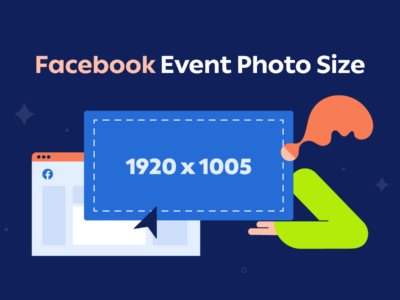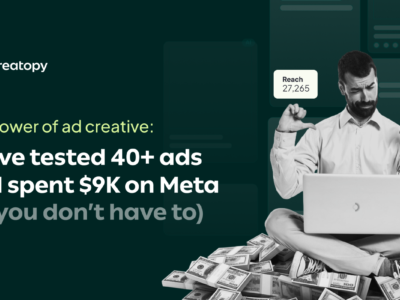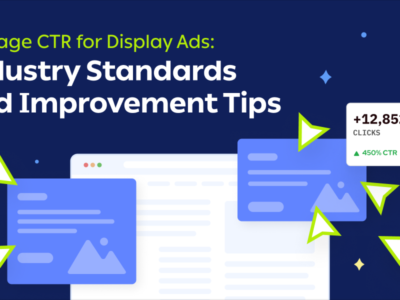“Selling” your business can be a more complicated experience than selling a product or a service.
Your business is the ambassador of your product and/or service. You want people to have faith in your product because they trust the business.
Faith and trust combined can make the difference between an average ROI and sky-high profits.
So how do you promote your business successfully? What types of business advertising are there? What are the things you need to keep in mind when creating business ads?
This guide will answer all three of these questions and hopefully give you the confidence and knowledge you need to kickstart a successful business advertising campaign.
Summary:
1. Business & product advertising
2. Types of business advertising
3. Advertising tips for your business
1. Business & Product Advertising
“Why put effort into business advertising? At the end of the day, what matters is the product, right?”
Yes and no.
There are two crucial reasons why you want to dedicate as much time and energy to business advertising as you do to product advertising.
First, it’s impossible to predict the buyer’s journey with 100% accuracy. Some people come across your business first before they find out anything about your product.
When this happens, you want to make sure that the image you’re projecting of your business matches the one of your product.
Second, people tend to trust brands they are familiar with, so they will often buy from those they already know.
Your product could be much better than your competitor’s in terms of quality and price, but if people have never heard of you, your chances of making the sale you were hoping for declines.
Not to mention people put a lot of thought into the brands they support with their money. If they don’t know your business, its values, and what it stands for, they will be more hesitant to buy from you.
While business advertising and product advertising are two different things, they nevertheless go hand-in-hand.
2. Types of Business Advertising
Business advertising itself has a long list of different types of advertising.
A business can be advertised in different mediums, whether they are online or offline, on TV or in real life, on pocket-sized flyers, or on gigantic billboards. You can conduct nationwide campaigns or stick to local advertising.
The type that works for your business largely depends on what kind of business you are, where your audience is, and how much budget you have. Since every medium requires a different approach, you must carefully consider what sort of advertising will bring you the results you hope for.
Remember, just because there are so many types of advertising that doesn’t mean that you have to take advantage of every single one. You don’t want to bite off more than you can chew.
Let’s take a look at seven types of advertising to consider for your business:
2.1. Social media advertising
Social media advertising is all the advertising that you see on social media.
More specifically, it refers to paid advertising on social media. You see these posts labeled as sponsored or promoted on your feed.
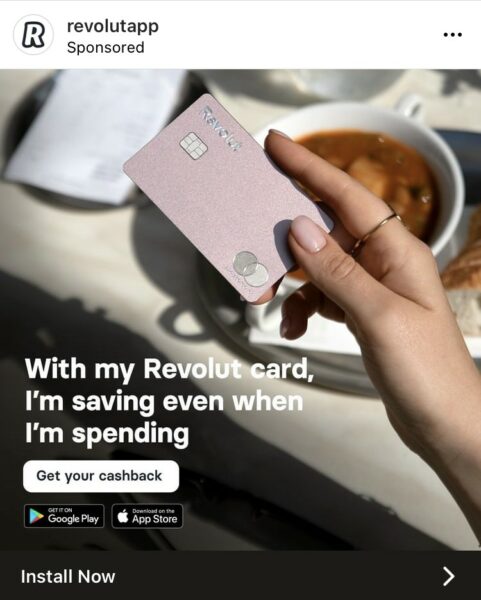
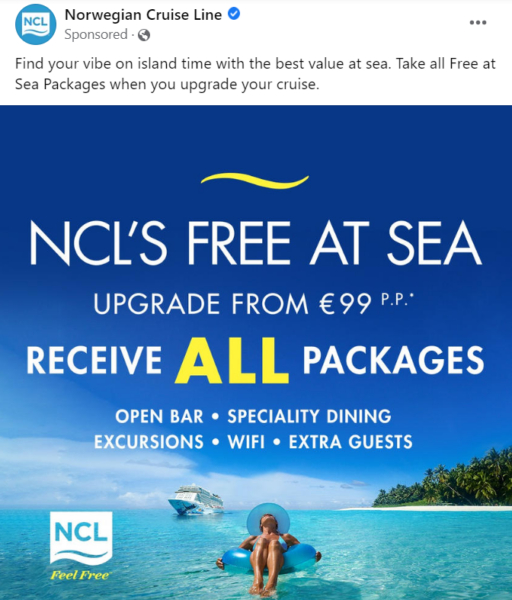
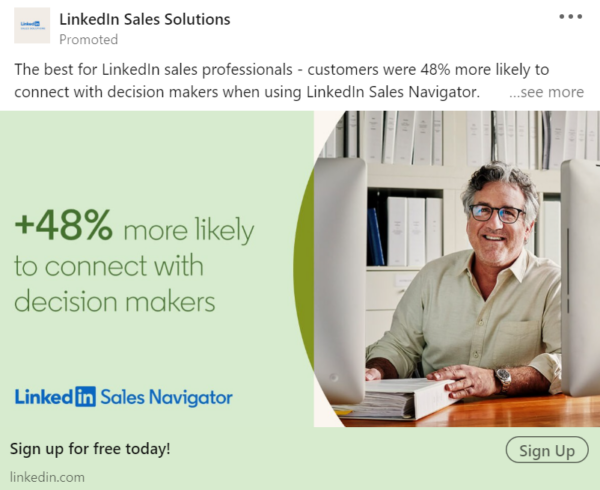
Typically they are either image or video ads, but they can also be interstitial and rich media ads.
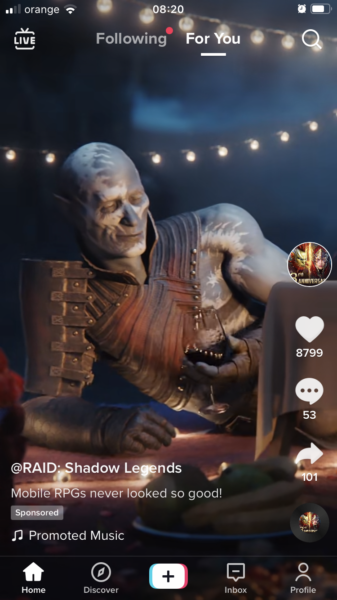
Another way you can advertise on social media is through sponsored content, which has become the go-to way of partnering with influencers to reach a wider audience.
This is when brands pay content creators a certain amount of money to advertise them through one or more posts. These posts are typically labeled as #ad or paid partnership with and always have the brand’s account tagged.
2.2. Pay-per-click advertising
Often called simply PPC advertising, pay-per-click is the type of advertising in which advertisers pay each time a user clicks on their online ad.
PPC advertising is offered both by search engines and social media platforms. Your PPC strategy will highly depend on which platform you choose to advertise on and your overall budget.
2.3. Mobile advertising
Mobile advertising refers to the ads that you see on mobile devices.
More specifically, it defines the ads that appear on apps and/or web pages that you open on your smartphone and/or tablet.
In the case of apps, these ads can usually be seen right when you open an app or while browsing it. Many mobile games even offer the option to watch an ad in exchange for rewards that can be used in the game.

In the case of web pages (pages you look at through your mobile browser, not an app), they can appear anywhere on the screen, whether in the form of a banner or a square in the beginning, middle, or even end of an article.

2.4. Print advertising
Print advertising is the old-fashioned form of advertising using posters, flyers, newspapers, and/or magazines.
Although online advertising is generally the most used form of advertising, that doesn’t mean that it’s time to neglect print.
People might not be reading newspapers and magazines as much as they used to, but they still like going out—after the tough quarantine in 2020, even the biggest homebody started to love the outside world more.
Posters can still catch people’s eyes, and flyers advertising tempting sales are a pleasant surprise for many people.
Print advertising can also get you noticed at local events. People tend to put their phones away while enjoying a carnival or food festival, which gives you a perfect chance to grab their attention with a really cool poster.
2.5. Broadcast advertising
Broadcast advertising is a term used for radio and television advertising. Opinions are somewhat divided—however, some people consider internet advertising to be part of the group, too.
Radio and television are two of the oldest forms of advertising, having set the stone for online advertising.
The very first TV ad, a 10-second commercial for Bulova watches from 1941, may look outdated by today’s standards, but it does nail the basics of a good ad: it’s quick, has a catchy slogan, and has an interesting visual. Radio ads have also perfected the ways in which businesses could reach out to radio stations and advertise their products in exchange for a fee.
Today, brands prioritize online advertising, but that does not mean that all hope is lost for broadcast.
Radio and television still have their fair share of listeners and viewers; if your target audience is part of them, it’s worth venturing into the market.
2.6. Out-of-home advertising
As the name suggests, out-of-home advertising is all the advertising that goes on outside of your home. It mainly refers to billboards and all the creative ways you can utilize them.
Out-of-home advertising is usually divided into two categories: traditional and digital.
Traditional out-of-home advertising refers to billboards (or sometimes posters) that are either static or mobile. Static ones have a large image that remains fixed in one location, while mobile ones are the ones you see on buses, constantly moving and changing their physical location.
Digital ones are the billboards showing up on passive digital screens, like the ones you see at the iconic Times Square in New York.
The cool thing about out-of-home advertising is how much room you have for creativity. Just because you are working with a huge rectangle, that doesn’t mean you have to limit yourself to its borders.
Here are just a few iconic examples of OOH advertisements that thought outside the box—literally.
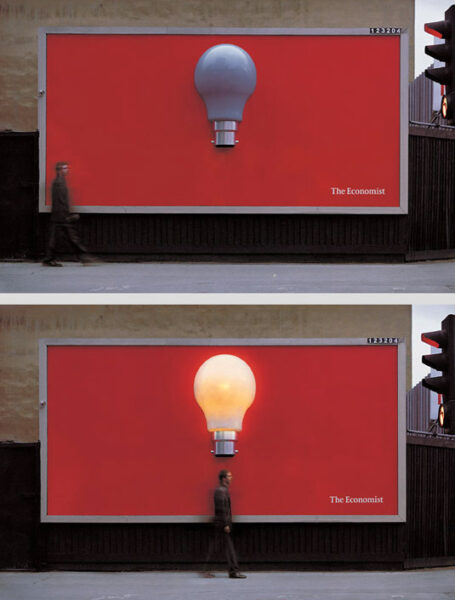
This interactive billboard advertisement by Abbott Mead Vickers BBDO for The Economist was equipped with a motion sensor, which made the light bulb go off every time someone was under it.

Netflix is known for its creative OOH advertisements, and this one advertising their hit show All of Us Are Dead did not disappoint. As the show is about a group of teenagers who must fight off zombies after being locked in their school, Netflix decided to send a school bus into the streets of Thailand that creatively displayed the terrifying plot of the show.
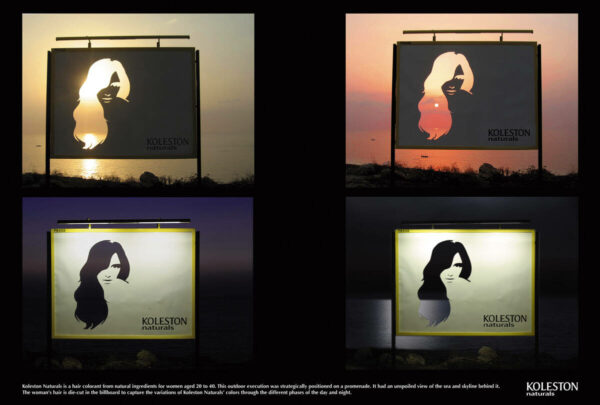
The placement of this advertisement for Koleston Naturals by Leo Burnett was strategically planned to take advantage of the sun’s position throughout the day, representing the numerous ways you can change your hair color with the product.
This 3D advertisement from Nike Japan is only one of the many new examples of using digital billboards to really pull your audience in. The 30-second animation is so seamless and visually stunning, you might want to reach out and grab the shoe.
2.7. Email advertising
Email advertising refers to all the ingenious ways you can advertise via email.
Newsletters are the most common type of email advertising. You can send them out weekly, bi-weekly, or anytime you wish. The key is to stay consistent.
If you have a blog, newsletters are an excellent way to promote your articles, whether they have to do with company updates or product launches.
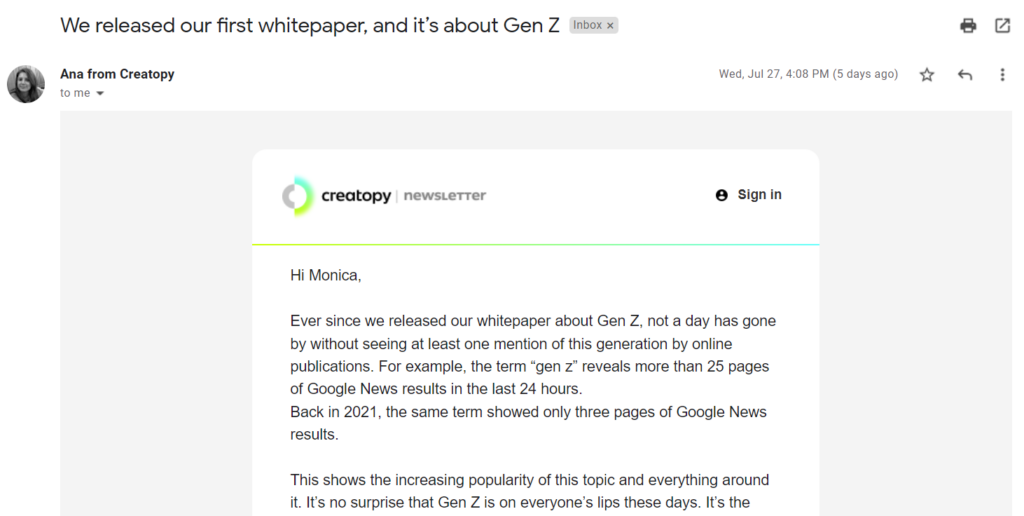
Another common type of email advertising is sponsored email ads.
These types of emails are curated by the email service you are currently using (Gmail, Yahoo Mail, etc.) They are specifically labeled as ads in your inbox.

3. Advertising Tips for Your Business
3.1. Have a clear visual identity
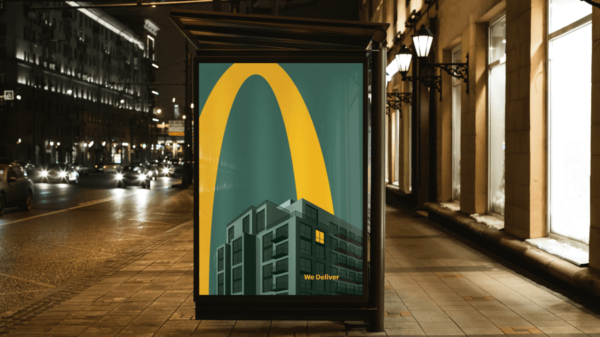
In 2021, Leo Burnette London teamed up with McDonald’s to advertise the latter’s delivery service.
The advertising agency decided on a minimalistic approach to the campaign, displaying posters and billboards without the McDonald’s logo or the famous I’m lovin’ it slogan. Instead, the designs relied solely on monochromatic color palettes and half of the iconic Golden Arch.
And that was all the public needed to know what was being advertised to them.
How was this possible?
McDonald’s has a solid visual identity.
No matter which advertising type you decide to focus on, your job will be infinitely more manageable if you have a well-defined brand visual identity.
Your brand’s visual identity is the collection of elements that make your brand recognizable. These generally include your unique logo, color palette, and typography.
Having a clear visual identity will not only make you more recognizable to the public, but it will also help your team save time when creating business ads and other marketing campaigns because they will be able to focus on their ideas without worrying about the endless font pairings they can make.
3.2. Assemble a brand style guide
Once you figured out your visual identity, it’s best to have everything written down somewhere for future uses.
This is where the brand style guide comes into play.
Otherwise known as a brand bible, a brand style guide is a collection of guidelines regarding how your brand needs to look. It’s important to have one as it helps designers stay consistent and marketers communicate better with each other.
It allows your employees to clearly understand your brand identity so they can pass it on to your target audience.
A brand style guide can be as short as long as you need it to be. The important thing is for it to be beneficial to your team. It needs to address any question that might come up regarding the way you want your brand to be seen in the world—whether we’re talking about colors or specific wordings.
3.3. Create a marketing plan
Now that you know what image you want to portray and what type of message you want to send about your business, it’s time to take a look at the channels through which you can successfully communicate with your target audience.
A marketing plan is just what you need for that to happen.
Your marketing plan is like a roadmap specifically meant to help you advertise effectively. Depending on your needs, vision, and budget, it helps you decide which types of business advertising you should dive into.
Do you want to try online and broadcast advertising, or do you want to focus on one for the time being? Do you want to lean into out-of-home advertising, or do you feel like that does not fit you?
Your marketing plan helps you create strategies for all your preferred types, nail the budget, and select your KPIs.
3.4. Get witty with your copy
While the power of images is undeniable, so is the power of words.
After deciding what are the channels through which you want to communicate, it’s time to plan your business ads. This means both designing and copywriting.
If you have your color palette sorted out, you’ll be able to pull together a mood board filled with inspirational images to picture your ideas.
But the images are more potent when accompanied by equally strong words.
Remember the McDonald’s campaign example? As effective as they were, thanks to their minimalistic designs, the ads still had the words We Deliver written on them—and those words made the difference between a generic ad for McDonald’s and a specific ad for McDonald’s delivery service.
The copy doesn’t have to be complicated. In fact, it’s best if it’s as short as possible. The point is to make it playful, witty, and, most importantly, memorable.
Conclusion
“Selling” your business is a different experience than selling your product.
While your product represents the idea, your business is the ambassador of said idea. It’s your most trustworthy salesperson. While they may be different, it’s important to ensure your product and your business are in sync if you want a strong brand image and awesome sales.
Which type of business advertising would you choose for your brand?


